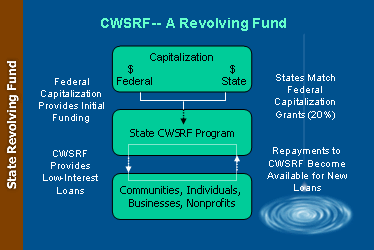
Watershed Academy Web
Introduction to the Clean Water Act

Loans are usually made at low (sometimes even no) interest. Although most loans have gone to local governments, they can also go to businesses or nonprofit organizations. Payback periods for loans extend to 20 years.
Most of the CWSRF dollars loaned to date have gone for construction expansion, repair, or upgrading of municipal sewage collection and treatment systems. But CWSRF loans can also be made for (1) NPS control projects consistent with a state, territorial, or tribal Section 319 program, or (2) implementation of a management plan developed under the National Estuary Program.
As of the end of 2001, over 30 CWSRFs had lent over $1.4 billion for nonpoint source projects. Such projects include loans to:
Managers of SRFs must comply with several basic requirements: